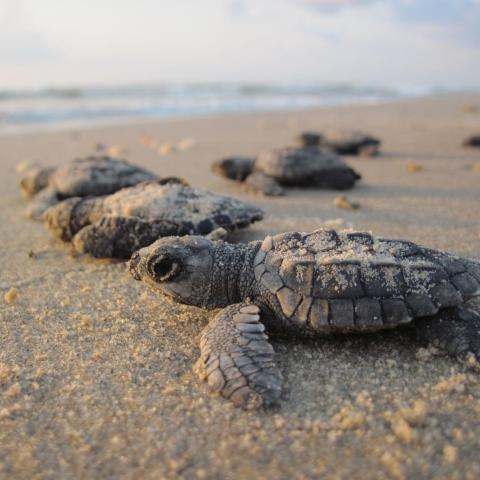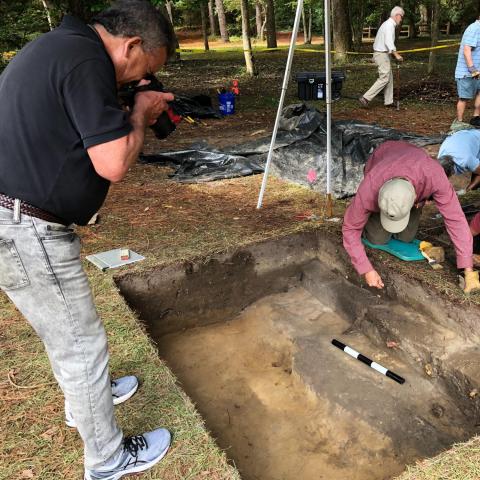At Cape Hatteras, Coastal Erosion Creates Costly Challenges For Residents, Tourists, And The National Park Service.
Editors note: This summer, the National Parks Traveler is taking a close look at Cape Hatteras National Seashore, which is grappling with serious issues related to its beaches, wildlife, and historic structures. This is the second of three articles, and part of the Traveler's look at climate-change impacts to parks along the Eastern Seaboard from Maine to Florida.
Jim Feaster has made a personal mission out of documenting the beauty of Rodanthe, a popular beach town on Hatteras Island, part of North Carolina’s Outer Banks. After vacationing there for many years, Feaster sold his home in Maryland and purchased his dream house in Rodanthe about ten years ago, located on the sound side of this thin barrier island. With water stretching to the horizon in opposite directions, he says it felt like he was living “in the middle of infinity.”
But now, so much has changed.
In the last ten years, Feaster has witnessed the closure of a section of North Carolina Highway 12—the main north-south artery on the Outer Banks—just north of Rodanthe, because of persistent coastal erosion, washouts, and flooding. Beach erosion has been so intense that, in the past four years alone, seven houses have fallen into the sea in Rodanthe, the most recent just last week, and dozens more face the same fate. How much beach has eroded? The island has retreated more than 200 feet at Rodanthe during the past two decades, according to the National Park Service.

Cape Hatteras Superintendent Dave Hallac discussed the risks the Atlantic Ocean poses to vacation homes at Rodanthe, North Carolina, with the Traveler's Kim O'Connell/Deputy Superintendent Robin Snyder
A software developer, Feaster founded and administers a popular Facebook group called Planet Rodanthe, which boasts more than 11,000 members. He frequently posts photos and videos of the ocean and sound, marveling at their beauty and inviting others to do the same. A regular subject for him is a house called the Black Pearl, a lone outpost on the northern edge of Rodanthe that looks as if it could topple into the waves at any moment. The house’s front steps now lead down to nothing, because all the sand around the house has eroded away.
Coastal erosion is a worsening problem for the staff of Cape Hatteras National Seashore, as well as residents, tourists, and local and state government. This month alone, Tropical Storm Debby tore up beaches in Rodanthe and made the waters unsafe to swim in, leading the Park Service to issue a warning to visitors. The ongoing situation has forced some new thinking about planning for climate change catastrophes—but it’s also raised tensions on a beloved seashore where many people feel a sense of ownership.
“We think there are somewhere between 25 and 30 threatened oceanfront structures in Rodanthe,” says Cape Hatteras Superintendent Dave Hallac. “It's changing almost on a weekly basis. But there are degrees of threatened. You have extreme situations [with some houses] that are in really, really bad shape where it would not be at all surprising to have a complete collapse of all these homes in the next 12 months.”
On a gray morning in July, Superintendent Hallac and a couple NPS colleagues took me on a tour of some of these threatened structures. We’d turned off Highway 12 and driven towards the ocean, where the asphalt ended abruptly at the dune line. Walking past the dunes, long denuded of sea oats or any other rooted vegetation that might help hold them in place, I immediately spotted a series of black tree stubs poking out of the breakers. They reminded me a little of cypress knees, if they were found in the churning ocean instead of in flat-water swamps. It turns out that I wasn’t all that far off.
“These are all the bases of trees from either a maritime forest or even freshwater swamp that was here,” Hallac explains. “And the reason that was here is that where we’re standing was once the interior or the sound side of the island. There’s so much erosion that now where there was a maritime and hammock or freshwater marsh is now the Atlantic coast. I wish I had a way to date them, but at a minimum, they’re hundreds of years old, but they could be much older than that.”

As the barrier island's sands move, they reveal the remains of a forest or swamp/Declan McCleaf
In 2018, work began on the Jug Handle Bridge, a 2.4-mile span completed in 2022 that carries Highway 12 from Pea Island National Wildlife Refuge north of Rodanthe, west into the Pamlico Sound away from the chronic washout area, and then east again to connect with the main road in the center of town. Even before the $145 million bridge was built, the state had invested millions to fill an inlet that was opened by 2011’s Hurricane Irene and perform other beach nourishment efforts. It was all essentially for nought; the beach continues to erode at Rodanthe at a rate of more than 13 feet per year. Because of a number of factors—sea level rise and worsening storms chief among them—there is not only horizontal erosion, but vertical erosion too.
Now, when Jim Feaster steps out onto his deck to watch the sunset, instead of an endless blue horizon, he sees the Jug Handle Bridge. Although he acknowledges the scope of the erosion, he represents a significant portion of Outer Banks homeowners who wish the government would do more beach nourishment at Rodanthe, which is the process by which sediment is dredged from the ocean and deposited on the beach to help maintain an existing shoreline. Beach replenishment projects occurred farther south on Hatteras Island in the towns of Avon and Buxton in 2022, with more planned for 2026.
“They built a bridge in my backyard,” Feaster says, “and that was an indication that ‘We don’t care about you’ or we’re not worthy to [have our beach] maintained.’”
But the new sediment from beach nourishment can bury the intertidal zone, causing habitat loss and disruption to coastal species—just to have the beach continue to erode. And it’s costly: Farther north, it costs $10 million every four years to replenish the beach at Ocean City, Maryland, a fully developed boardwalk town. For the Outer Banks, Dare County recently estimated that the cost for a one-time nourishment near the Pea Island National Wildlife Refuge and Rodanthe would range from about $22 million to $40 million—or about $175 million over the next 30 years. The average sea level rise during that same timeframe is expected to be about a foot, which is more than enough to reshape the American coastline as we know it.
A 2023 study by Western Carolina University's Program for the Study of Developed Shorelines a suggests it would be much less costly to buy out the homeowners rather than investing in beach nourishment work. The report, by Rob Young, director of the program, places the cost of buying 80 houses — one dating to 1965 — at risk of being pulled into the Atlantic at Rodanthe at nearly $43 million.

The Atlantic Ocean is slowing reclaiming the shoreline along the Outer Banks/Declan McCleaf
On the day I visited Rodanthe, the problem felt much more immediate. Just beyond the remnant maritime forest stood five abandoned houses right at the water’s edge. Perched on stilts, they looked a little like giant shore birds standing on impossibly thin legs, their stilts exposed nearly down to their bases. All long abandoned, these houses may very well be the next ones to succumb to the ocean, but there’s no way of knowing which storm—or which set of waves—will kickstart the process.
That lack of predictability has caused major headaches for the Park Service. Every time a house collapses, the ocean current can spread debris far down the beach in a matter of hours, including trash, furniture, and toxic waste. As we walked down the beach, several septic tanks could be seen, uncovered by erosion and long emptied of their contents. It’s a potential nightmare not just for the beachgoing public, but also wildlife and habitat.
“When you have raw, untreated sewage going into a national park, it's a significant issue,” Hallac says. “We had a house that collapsed in May. We ended up removing, I think, 89 truckloads of debris, and we had over 100 staff over a week working on it.”

Water quality suffers when the ocean unearths septic systems/Declan McCleaf
To get ahead of the issue, with funding from the Land and Water Conservation Fund, NPS purchased two houses in danger of collapse last year, with the aim to control their demolition and return that section of beach to public access.
“It was a pilot program,” Hallac explains. “We'd love to scale it up, but the funding to do something like that, and even just the time…it sounds simple, but to get appraisals done, to get the money, to negotiate with the homeowners, to get all the paperwork that's done, I had to do a lot of that myself. It takes a lot of time. So we just don't feel like we have the capacity to scale up yet, but we're very interested.”
Hallac reports that he is meeting with foundations and seeking funding support to continue that effort. He is not sure if this type of buyout program is the first of its kind in the national park system, but it’s certainly the first of its kind at Cape Hatteras. For many observers, the seashore is a bellwether in terms of how coastal parks will deal with climate change. We can count on losses, for sure, but perhaps there will be gains as well.
For Jim Feaster, the Black Pearl and other Rodanthe houses are a symbol of holding on despite the odds. “Be defiant like the Black Pearl,” he wrote on a recent Planet Rodanthe post. Living on the sound side of the island, Feaster knows he has a little more time than the oceanfront properties. But the sand is still shifting beneath his feet.
“Living here is an experience that is truly magical,” he says. “Dangerous, but magical.”






 Support Essential Coverage of Essential Places
Support Essential Coverage of Essential Places







Comments
I would like to know, for the houses most at risk, how long the owners have been there. I definitely sympathize with anyone who has been there, say, more than 10 years. Those people should get assisted buyouts and reasonable compensation. Those who bought recently, on the other hand, should have known better and probably did so hoping for a taxpayer funded bail out. They should be left to deal with their insurance companies and have to fund the cleanup.